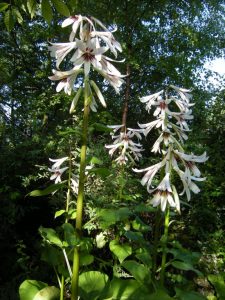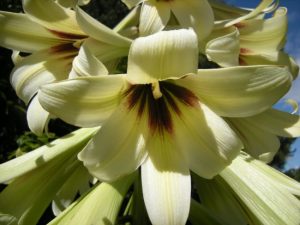Cardiocrinum giganteum is one of the prizes of the Himalayan flora. Collections in the Garden have come from the provinces of Yunnan and Sichuan in south-west China. In the wild, it grows at 2400-2600m in degraded open forest with Abies and Larix sp. in Yunnan and within damp glades in mixed woodland with Acer sp. and Rhododendron rubiginosum in Sichuan Province. This giant lily is a gem to collect – its seed, tightly packed in the pods, burst out like coins from a cash machine.
To get the best out of these seed-grown plants, they are introduced into woodland areas at Edinburgh. Being monocarpic it is essential to sow seed each year bulking up plantings for successive flowering. Initially growth is a basal rosette of leaves these develop over five to seven years until the bulb reaches flowering size.
Leave the flowering stalks once flower colour and petals have dropped – these make bold statements during late autumn and winter when they dry naturally to a handsome brown shade.
Grouped in dappled shade, the plants are showing their variability in form; the tallest exceeding three meters in height in the Copse and the most densely packed heads in the Woodland Garden sporting in excess of two dozen individual blooms with stems thicker than a hand’s grip. Flower colour varies from white to cream to a very delicate shade of green. Most are suffused with shades of vermillion in the throat of the bloom and on the outer of the petal less so.
Each and every one is laden with scent, all the more powerful and heavily intoxicating this rainy mid-summer.


